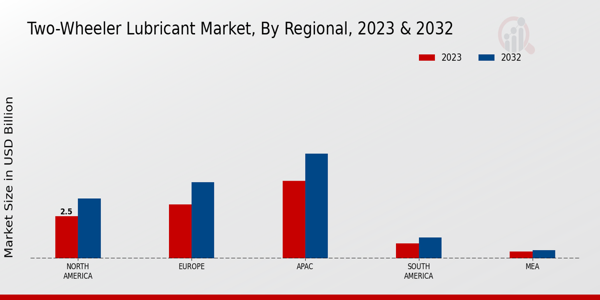Increase in Two-Wheeler Sales
The Two-Wheeler Lubricant Market is experiencing a notable surge due to the increasing sales of two-wheelers across various regions. As urbanization accelerates, more individuals are opting for two-wheelers as a cost-effective and convenient mode of transportation. In 2025, the sales of two-wheelers are projected to reach approximately 25 million units, which directly correlates with the demand for lubricants. This rise in vehicle ownership necessitates regular maintenance, thereby driving the lubricant market. Furthermore, the growing trend of personal mobility, especially in densely populated areas, is likely to sustain this upward trajectory in two-wheeler sales, consequently boosting the Two-Wheeler Lubricant Market.
Rising Awareness of Vehicle Maintenance
There is a growing awareness among consumers regarding the importance of regular vehicle maintenance, which significantly impacts the Two-Wheeler Lubricant Market. As riders become more informed about the benefits of using high-quality lubricants, the demand for specialized products is likely to increase. This trend is evident as more consumers are investing in premium lubricants that enhance engine performance and longevity. In 2025, it is estimated that the market for high-performance lubricants will account for over 30% of the total two-wheeler lubricant sales. This shift towards quality products indicates a maturation of consumer preferences, which is expected to further stimulate growth in the Two-Wheeler Lubricant Market.
Expansion of E-Commerce and Distribution Channels
The Two-Wheeler Lubricant Market is benefiting from the rapid expansion of e-commerce and diversified distribution channels. As online shopping becomes increasingly prevalent, consumers are more inclined to purchase lubricants through digital platforms, which offers convenience and often better pricing. This trend is particularly pronounced among younger consumers who prefer the ease of online transactions. In 2025, it is estimated that e-commerce will account for nearly 25% of total lubricant sales, indicating a significant shift in consumer behavior. Additionally, the establishment of more retail outlets and partnerships with automotive service providers is likely to enhance product accessibility, further propelling growth in the Two-Wheeler Lubricant Market.
Technological Advancements in Lubricant Formulations
The Two-Wheeler Lubricant Market is significantly influenced by ongoing technological advancements in lubricant formulations. Innovations such as the development of synthetic and semi-synthetic lubricants are enhancing performance characteristics, including improved thermal stability and reduced friction. These advancements not only extend the life of two-wheeler engines but also contribute to better fuel efficiency. As manufacturers continue to invest in research and development, the introduction of new formulations is expected to attract a broader consumer base. By 2025, it is anticipated that synthetic lubricants will represent a substantial portion of the market, reflecting the industry's shift towards more advanced and efficient products.
Environmental Regulations and Sustainability Initiatives
The Two-Wheeler Lubricant Market is increasingly shaped by stringent environmental regulations and a growing emphasis on sustainability. Governments are implementing policies aimed at reducing emissions and promoting eco-friendly products, which is driving the demand for biodegradable and low-impact lubricants. As consumers become more environmentally conscious, the market for eco-friendly lubricants is expected to expand significantly. In 2025, it is projected that the share of environmentally friendly lubricants in the two-wheeler segment will increase by approximately 20%. This shift not only aligns with regulatory requirements but also reflects a broader societal trend towards sustainability, thereby influencing purchasing decisions within the Two-Wheeler Lubricant Market.
























Leave a Comment